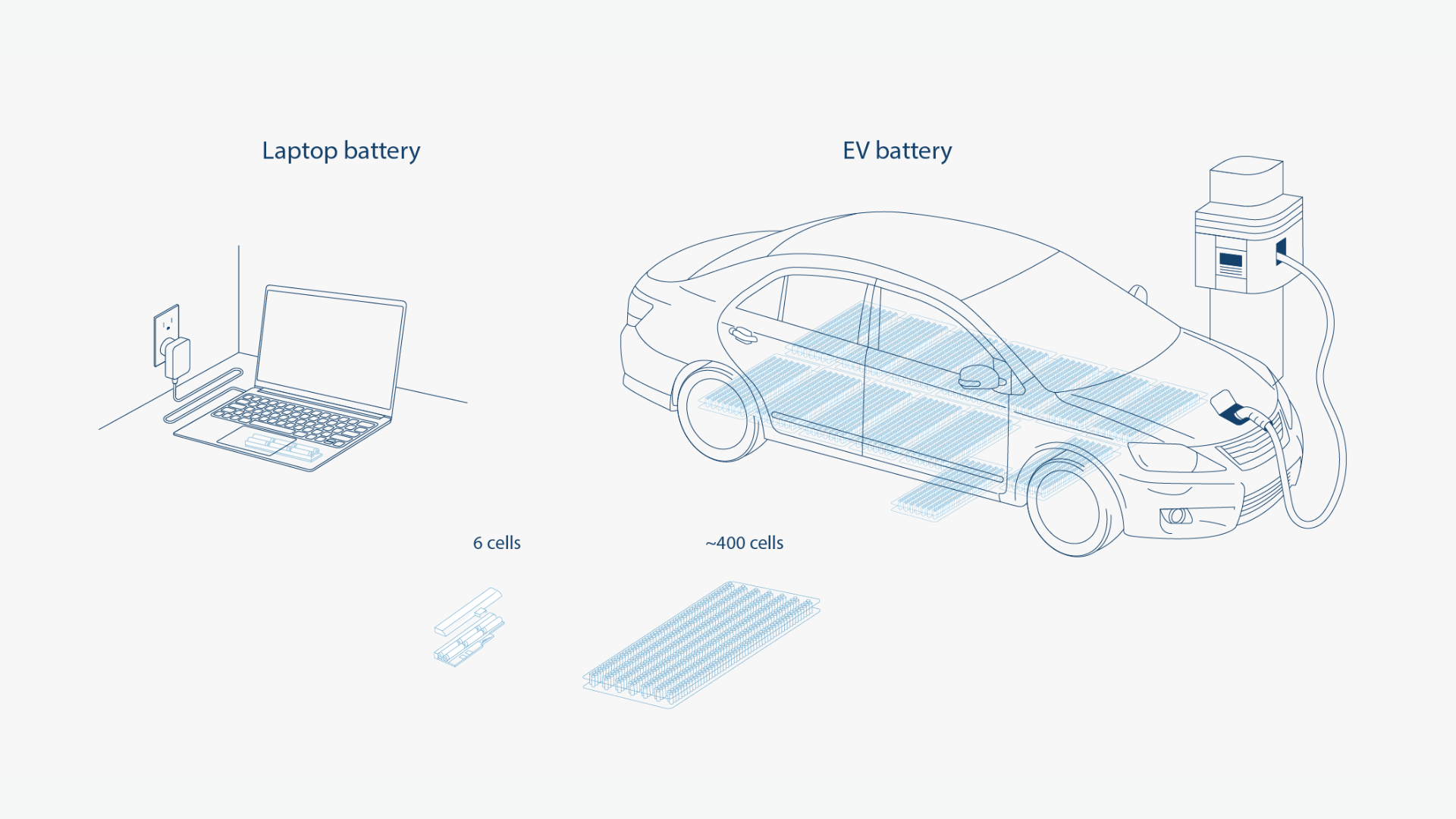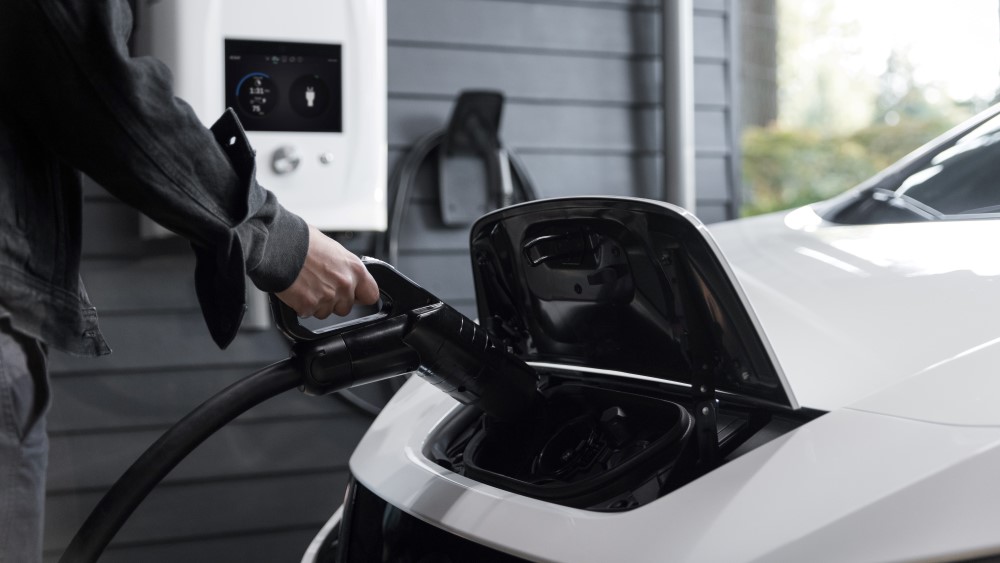Topics covered in this article
- How an EV battery works
- Charging at home and on the go
- Extending EV battery lifespan
- Wireless EV charging
So, a new EV has caught your eye. Maybe the aerodynamic design cues like the grill-less fascia or sweeping lines sent your heart aflutter, or perhaps pain at the pump is making you rethink the loyalty you have towards your current car. If you buy an EV, here’s what you need to know about the massive battery that lies within, and how to go about recharging it.
What’s under the hood? Free space
An EV is a car without a combustion engine. Pop the hood and marvel at the extra storage space of the frunk – a front trunk. The vroom-vroom magic really takes place beneath the floorboard where, if you put your X-ray specs on, you’d see groups of interconnected battery cells housed in enclosures called modules. Several modules tied together comprise the entire battery pack, which is securely reinforced and isolated from external shock and extreme temperatures.
When Tesla led the EV charge over ten years ago, tried-and-true cylindrical battery cells (slightly larger than AA batteries) were favored. The Tesla Model Y crossover still uses more than 4,000 tube-shaped cells. Other carmakers are experimenting with new battery pack designs. General Motors’ latest EV chassis, dubbed Ultium, sports thin rectangular pouch-style battery cells that can be stacked to bring more power in a smaller form factor.
What’s in a battery?
Like any rechargeable battery, a single EV battery cell holds a positively charged cathode (containing metals like lithium, cobalt and nickel) on one end, and a negatively charged anode (usually made of graphite) on the other. When both ends are connected in a circuit, electricity can flow through the battery, but a chemical reaction that takes place inside the battery is what keeps it flowing. Contrary to popular belief, a battery doesn’t store electricity per se. When a battery is recharged, the chemical reaction is reversed until the battery reaches its initial state, ready to become a power source all over again.
Charging an EV battery: Levels 1, 2 and 3
Level 1 charging
An EV is similar to your laptop: once the battery charge falls too low, you’ll have to plug it in to recharge. Also like your laptop, EVs come with a charging cable that you can use with a standard household outlet. But that’s where the similarities end, because typical EV battery capacity is about a thousand times greater than that of a laptop battery. This relatively tame Level 1 charging method — also called trickle charging because it can take 18 or more hours to give a full charge — is too slow for most drivers.

Level 2 charging
EV charging stations are machines that can refuel an electric car quickly because they’re connected to upgraded electrical infrastructure and output a stronger charge. Here’s a simple way to break down charging times (we promise that even non-electricians will understand):
- Know your EV’s battery capacity in kilowatt-hours (kWh)
- Note the power output of the charger you’re using, measured in kilowatts (kW)
- Divide the battery capacity by the power output. The result indicates how many hours it will take to fully recharge your EV battery
When homeowners decide that an EV is right for them, many choose to install a dedicated Level 2 EV battery charger in their garage that can supply anywhere from 3.8 kW to 12 kW of power – and sometimes more.
A × V = W
Some manufacturers of Level 2 chargers express power in amps (A). To figure out how that translates into a kilowatt-based charging rate, multiply amps by volts. Home chargers generally use a 240-volt power supply.
Remember to divide the result by 1,000 to turn watts into kilowatts:
40 A × 240 V = 9,600 W, or 9.6 kW.
Using an EV battery charger is easy. Most EVs have a small door covering the charging inlet that resembles the gas cap cover of a traditional car. Open it, insert the connector, and the EV should begin recharging. Feel free to leave it unattended. Special pins in the connector monitor the entire process for safety and handle communications between the charger and the battery, so you don’t have to think about checking in on your car. You can charge while you sleep and have a full battery ready to go in the morning.
Many Level 2 devices are Wi-Fi or Bluetooth enabled and come with smart charging capabilities. Using a smartphone app, you can schedule charges or participate in utility demand response programs, receive status updates and maintain control over the process from afar.
Level 2 charging hints
Something to keep in mind: more powerful home EV chargers tend to require electrical panel upgrades. Are they worth the extra cost? Maybe not. All batteries require electricity to be converted into direct current (DC), but the electrical grid delivers power in alternating current (AC) format. While many public charging stations convert AC into DC before it enters the vehicle, Level 2 chargers for the home rarely do. This means that the EV needs to do the power conversion internally. It will do its best – and no more. If your vehicle only accepts 7.6 kW of AC power, a 12 kW Level 2 charger won’t provide improved performance. In case you’re wondering, dcbel home energy stations get around this limitation by supplying DC power.
Level 3: Recharging while on the road
Drivers also have recharging options outside the home that make even the longest road trips a breeze. Tesla drivers have a plethora of options, with 1,200 Supercharger stations scattered throughout the US and Canada. While this particular network may be accessible to non-Tesla drivers in the future, anybody can visit one of the 43,000 public EV charging stations currently operating in the US.
Using a free online map like PlugShare, you can get a great overview of charging locations filtered by charging speed, preferred network, price, and even station amenities like dining and shopping. Public fast chargers can output 50 kW all the way up to 350 kW. Pull up to one and you’ve reached Level 3.
Frequent users of public charging stations belonging to a particular network, such as Electrify America or EVgo, may want to spring for a membership to unlock better rates.
This service tends to cost 30 to 40 cents per kWh, which is more than double what you’d pay at home in most cases, but these chargers can’t be beat for sheer speed and convenience. When you pull into a public charging station, you’ll choose an available outlet, connect the charger to your vehicle and refer to the screen for payment instructions.
During Level 3 charging, aim for an 80% fill-up, and then turn to a Level 2 station for a full charge if needed. The last 20% of the battery charges much more slowly, so you’ll be overpaying for the service by sticking around too long.
Take a look at our handy table comparing all your EV charging options here.
Prolonging battery life
All batteries begin to suffer performance issues after years of use. To keep your battery healthy, try to restrict use of those super-fast Level 3 chargers to long road trips only. They’re very powerful and can generate quite a bit of heat, all of which negatively affect battery chemistry over time. Research also suggests minimizing the amount of time batteries spend either fully charged or fully depleted.
The future of EV charging
Have you ever used a wireless charging pad to re-energize your smartphone? Picture a car-sized version that allows you to park on top and walk away. There is a standard in place for wireless EV charging rated at 11 kW, and carmakers like Volvo are experimenting with higher-power versions of this setup. Taken to the extreme, wireless charging infrastructure could be embedded along long stretches of highway and charge EVs as they drive. This technology will make its first appearance in the US in 2023 as part of a pilot program in Michigan.
The number of EV charging options is ever expanding, which means drivers can relax and enjoy the journey knowing their destination is within reach.


